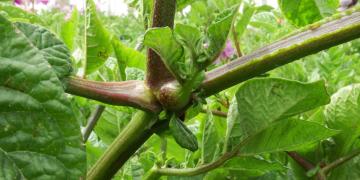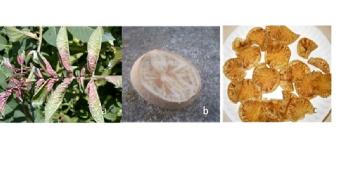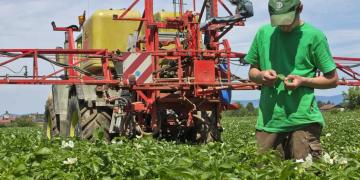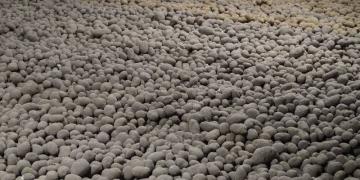Luxembourg must protect its crops against new pests
Reed leafhoppers can carry bacteria that harm potatoes and other crops. They are already present near the border.
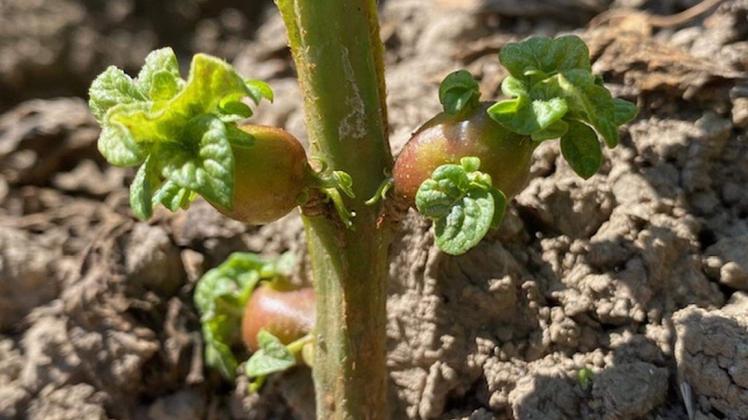
In Germany, an insect smaller than its name is causing a lot of damage in fields: the rush leafhopper. This animal, measuring only a few millimeters in size, has not yet spread to Luxembourg, fortunately for farmers who grow potatoes or sugar beets. Indeed, these insects can transmit bacteria.
For example, the bacterium Candidatus Phytoplasma solani, which causes stolbur in sugar beets and leads to "low sugar syndrome" (LS), i.e. a decrease in the sugar content of the vegetable, or even a loss of yield.
But stolbur can also be transmitted to potato plants. The German Federal Ministry of Agriculture, Food and Homeland describes the effects of plant contamination with this bacterium as "rubber beets" and "small, soft tubers." The damage ranges from reduced quality to crop loss.
Asta speaks out
Some Luxembourg farmers have already become aware of the problem in the neighboring country, and the Administration of Technical Services for Agriculture (ASTA) is also concerned about this potential danger. This is the conclusion of a press release issued in response to a parliamentary question from two DP deputies, André Bauler and Luc Emering.
Asta emphasizes that the pathogens pose no danger to humans. And that to date, neither the flavescence dorée leafhopper nor the pathogens of the SBR or the stolbur have been detected in Luxembourg.
However, stolbur is already a regulated non-quarantine pathogen (RNQP) in Luxembourg, and potato plants must legally be free of stolbur. If this pathogen is detected on a plant, measures must therefore be taken, such as the removal and destruction of the plant and its tubers.
The Asta Phytopathology Department regularly examines plants for the aforementioned diseases in close collaboration with foreign laboratories and experts, the statement added. In addition, monitoring of susceptible crops is also planned this year. The goal is to detect any spread of leafhoppers in order to take measures as quickly as possible against potentially transmitted diseases. Farmers can report diseased plants or the sighting of a leafhopper to the Asta Phytosanitary Department.
Annual Monitoring"We carry out annual monitoring, and this year we are also paying particular attention to the reed leafhopper," explains a plant health service employee interviewed by the Luxemburger Wort . "We started monitoring in mid-May and evaluate the traps every week." As of June 20, none of the currently non-declarable animals had been discovered in the traps.
If there are already reed leafhoppers in Luxembourg’s fields, they could currently be trapped by Asta, because "the nymphs emerge from the soil around May or June, depending on the temperature, and lay their eggs on the roots of the plants," explains the Asta employee. If a reed leafhopper were found in one of the traps installed in the potato and sugar beet fields, and confirmed as such by the plant pathology laboratory, Asta would communicate concrete measures to the potentially affected farms.
According to the Asta employee, these measures are those that are "known and implemented in Germany." Emergency authorizations for plant protection products are possible, but only if pathogens are also detected in the captured leafhoppers.
Current situation in Germany
In an interview with the Luxemburger Wort , the Julius Kühn Institute (JKI), Germany’s Federal Institute for Crop Research, provided an overview of the current situation in the neighbouring country. "Since the first sugar beets showing symptoms of the so-called SBR disease were found in southern Germany in 2008, the situation has changed dramatically," says JKI spokesperson Stefanie Hahn. This is primarily due to the reed leafhopper’s high adaptability.
In 2022, it was proven that the leafhopper had switched hosts to potatoes and could now thrive on these host plants, which belong to a completely different plant family. The insect multiplied rapidly, so that by the end of 2024, 85,000 hectares of sugar beet and 22,000 hectares of potatoes were infected with the bacterium throughout Germany. In Hesse, the cultivation of seed potatoes has almost ceased, according to the JKI.
In the meantime, one of the bacteria transmitted by the sedge leafhopper has also been detected in onions, beetroot, and carrots. Experts therefore assume that leafhoppers also visit these crops. According to a current recommendation from the plant protection services of all German states and the JKI, the leafhopper population cannot be reduced by isolated measures. Instead, an integrated pest management approach with several plant protection measures is required , according to JKI scientist Sabine Andert.
"Race against pathogens"
"There is scientifically based evidence that crop rotation, with the avoidance of winter crops after beet or potato, can significantly reduce the pest population," explains Sabine Andert. Another factor is maintaining as much distance as possible between susceptible crops and areas infested the previous year. This is because the animals are highly mobile, a factor that makes control more difficult.
The use of insecticides is currently only permitted under emergency permits in so-called "hotspot" regions. According to the JKI, these are one-off measures in the hope of preventing adults from mating. Other potential control approaches currently under study at the JKI include the use of antagonistic fungi that, if possible, only attack unwanted leafhoppers, and "mating disruption," i.e., the control of reproduction.
According to JKI spokeswoman Hahn, the institutions involved are ultimately "in a race against the trio of harmful agents consisting of bacteria and insect vectors." The latter has so far proven extremely adaptable. For example, no one anticipated that the animals would leave their native ecosystem to find sugar beets and later even potatoes as host plants.
Fuente: Luxemburger Wort







